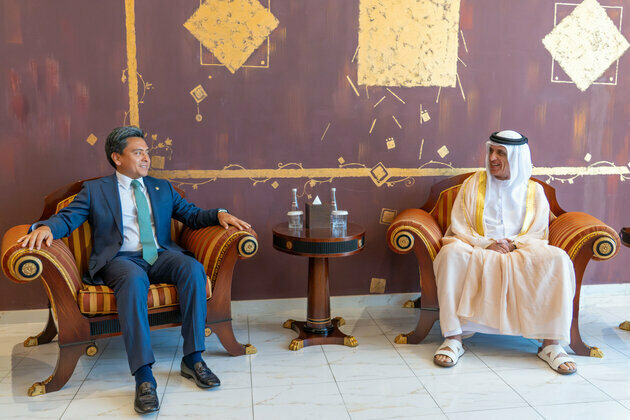The Inca string code that reveals Peru's climate history
The Conversation
17 Jun 2025, 12:48 GMT+10

Five centuries ago, the Incas ruled the western half of South America with the help of a unique form of writing based on coloured and knotted cords. These strings, called khipus, recorded major events, tracked economic matters, and even encoded biographies and poetry, according to the Spanish chroniclers who witnessed their use.
Most khipus have knots that indicate numbers that we can "read", but we've lost the ability to interpret what those numbers mean. Recent discoveries are bringing us closer to deciphering these mysterious strings. In a remote community set high in the Peruvian Andes, my team and I have found khipus that were used by villagers to track climate change.
Last year, I was invited to study the centuries-old khipus preserved in the village of Santa Leonor de Jucul in the Peruvian Andes. The 97 khipus conserved by villagers include the largest khipu in the world, which is over 68 metres long.
Looking for something good? Cut through the noise with a carefully curated selection of the latest releases, live events and exhibitions, straight to your inbox every fortnight, on Fridays. Sign up here.
An elderly ritual specialist, Don Lenin Margarito, told me that the khipus recorded the annual ritual offerings given at different sacred places in the surrounding landscape. Miniature pink ritual bags stuffed with coca leaves and tobacco hang from the cords, representing the sacred purpose of these ancient strings. Rather than communicating through knots, the Jucul khipus record data with different kinds of tassels.
For example, a tassel made of fuzzy beige llama tails indicates that an offering was performed at the sacred lake of Paccha-cocha, high in the mountains. The fluffiness of the llama tails is like a rain cloud, Don Lenin explained, representing the fact that offerings given at Paccha-cocha are thought to bring rain.
Different kinds of tassels indicate offerings made at other ritual sites, each one of which is thought to have its own effect on the local environment. Rituals involving the spirits of the dead, for instance, are thought to halt flooding.
If you look at one of the Jucul khipus and you see that there were a lot of offerings to Paccha-cocha that year, you know that this was a time of drought since the offerings were given to increase the rain.
When speaking with community members, we learned that the khipus used to be kept in public so that they could be consulted by the elders. Andean people of the past looked at these khipus as a record of the climate, and they studied them to understand the patterns of what was going on, just as we do today.
New methods for obtaining precise radiocarbon dates for khipus have been pioneered by a team headed by khipu researcher Ivan Ghezzi.
Efforts are now underway to get accurate radiocarbon dates for the Jucul khipus, which will provide a chronology of these climate-based offerings.
If we can chart the khipus and then date them, we will have a record of climate data from this region that was created by the local Andean people themselves. In their current state, the Jucul khipus are threatened by insects, mould and rodents. The British Museum recently granted funding to clean, preserve and display the khipus so that these precious objects from the Andean past will persevere into the future.
There are only five villages in the Peruvian Andes where ancestral khipus are kept. These rare archives offer tantalising clues about how khipus encoded information.
Research in other villages with living khipu traditions has led to breakthroughs in the significance of khipu colour patterns and phonology. Many Inka khipus possess tassels which we believe may reveal the subject matter of the associated khipu. If we could unlock the significance of the tassels on the Jucul khipus, it might allow us to interpret more precisely the meaning of Inca cords.
 Share
Share
 Tweet
Tweet
 Share
Share
 Flip
Flip
 Email
Email
Watch latest videos
Subscribe and Follow
Get a daily dose of Caribbean Herald news through our daily email, its complimentary and keeps you fully up to date with world and business news as well.
News RELEASES
Publish news of your business, community or sports group, personnel appointments, major event and more by submitting a news release to Caribbean Herald.
More InformationBusiness
SectionNippon Steel deal requires US security agreement
WASHINGTON, D.C.: This week, President Donald Trump signed an executive order that facilitates Nippon Steel's potential investment...
Spotify, Discord disrupted by brief Google service glitch
MOUNTAIN VIEW, California: On June 12, Google announced that it had fixed a temporary global service disruption that impacted several...
U.S. stocks forge ahead despite Mideast turmoil
NEW YORK, New York - U.S. stock markets closed in positive territory Monday despite the raging war in the Middle East which has killed...
Foxconn iPhone exports from India now mostly headed to the US
NEW DELHI, India: Amid mounting U.S.-China trade tensions, Apple has sharply increased iPhone shipments from India to the United States,...
US: China lags in AI chips, but catching up fast
WASHINGTON, D.C.: The U.S. government estimates that Huawei will only be able to manufacture up to 200,000 advanced AI chips next year—well...
Chime soars in debut, giving fintech sector a much-needed boost
SAN FRANCISCO, California: After months of muted IPO activity in the fintech world, digital bank Chime Financial reignited investor...
Latin America
SectionDebt fears drive fund outflows from US, inflows to Europe
NEW YORK CITY, New York: Investor confidence in U.S. markets is showing signs of strain as global funds redirect billions toward Europe...
Ruler of Ras Al Khaimah receives Ambassador of El Salvador
RAS AL KHAIMAH, 17th June, 2025 (WAM) -- H.H. Sheikh Saud bin Saqr Al Qasimi, Supreme Council Member and Ruler of Ras Al Khaimah, today...
The Inca string code that reveals Peru's climate history
Five centuries ago, the Incas ruled the western half of South America with the help of a unique form of writing based on coloured and...
(SP)U.S.-PHILADELPHIA-FOOTBALL-FIFA CLUB WORLD CUP-GROUP D-CR FLAMENGO VS ESPERANCE DE TUNISIE
(250617) -- PHILADELPHIA, June 17, 2025 (Xinhua) -- Onuche Ogbelu (C) of Esperance de Tunisie vies for the ball during the Group D...
(SP)U.S.-MIAMI-FOOTBALL-FIFA CLUB WORLD CUP-GROUP C-CA BOCA JUNIORS VS SL BENFICA
(250617) -- MIAMI, June 17, 2025 (Xinhua) -- Angel Di Maria of SL Benfica reacts during the group C match between CA Boca Juniors of...
Indian diaspora hails PM Modi's visit as beginning of a new chapter in Canada-India relations
Calgary [Canada], June 17 (ANI): Prime Minister Narendra Modi's brief visit to Canada has sparked excitement and optimism among the...












